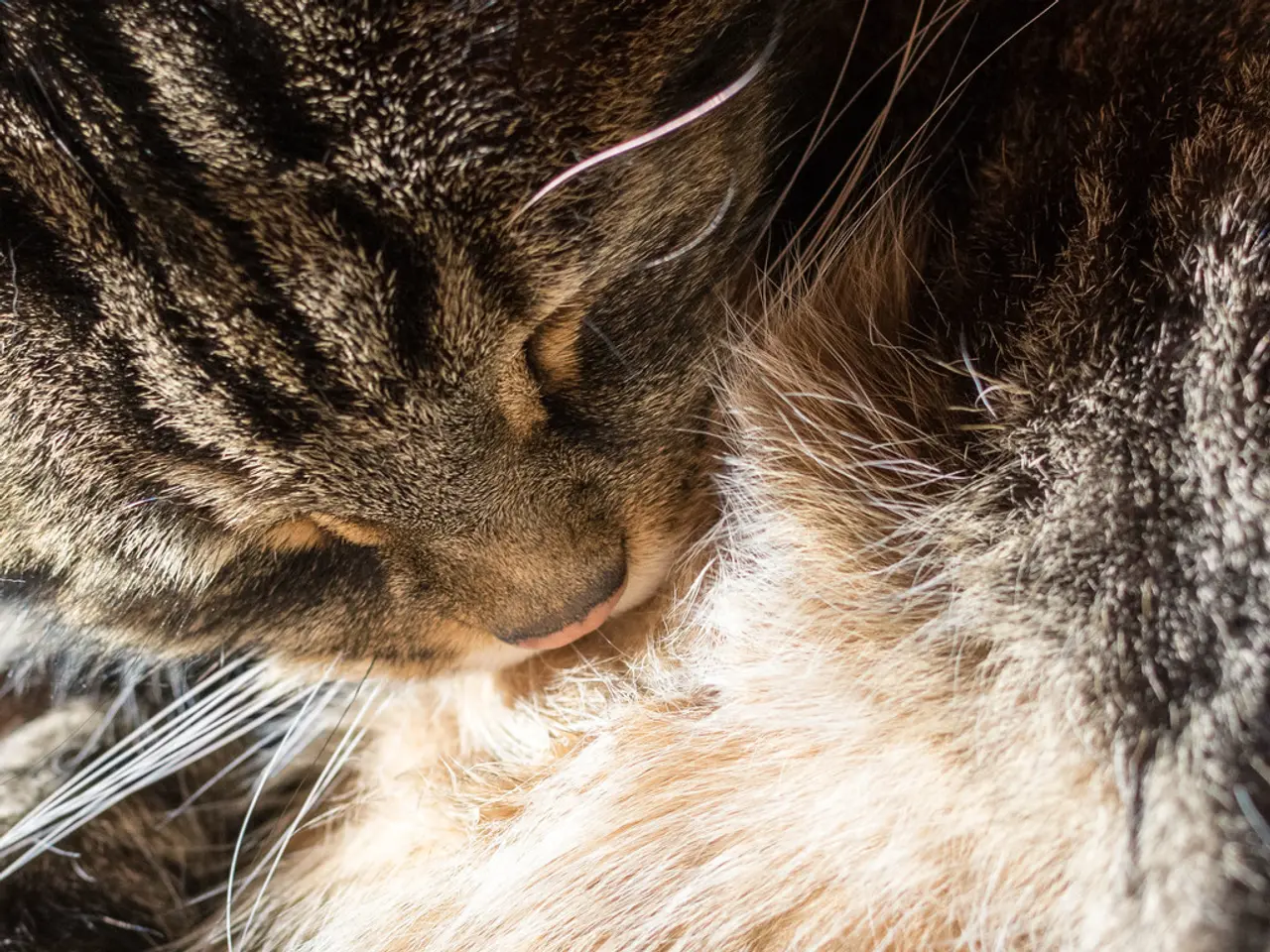Feline Gingivitis: A Progressive and Painful Early Stage of Dental Disease in Cats
======================================================================
Cats may exhibit a range of signs when suffering from gingivitis, a common dental disease. These signs include red, swollen gums, bleeding gums, bad breath, drooling or saliva with traces of blood, difficulty eating, pawing at the mouth, decreased appetite or weight loss, changes in behavior, and drooling or saliva with traces of blood [1].
Fortunately, there are several steps pet owners can take to prevent and manage gingivitis at home. The most effective method is daily tooth brushing using a cat-safe toothpaste, as this stops plaque from turning into tartar and causing gum inflammation [1][4][5]. If brushing is difficult, alternatives such as dental gels, dental treats, dental diets, dental sprays, dental toys, and water additives designed to reduce plaque and tartar buildup can be used [1].
For milder cases, brushing with a pet-safe toothpaste or a muslin cloth, along with the use of dental toppers and supplements, can help manage the condition [2]. Natural mouth drops containing ingredients like white oak, plantain, sage, echinacea, myrrh, and neem have antibacterial and anti-inflammatory properties that soothe gums, reduce bacteria, and improve oral health [3].
To help with the introduction, brush your cat's teeth gradually, allowing them to get used to the taste of toothpaste and the feel of the brush [4]. Brush the outer surfaces of teeth gently and speak calmly to encourage cooperation [4]. Even brushing every few days can be beneficial if daily brushing is not possible [4].
Encouraging your cat to drink more water and using dental water additives can also support oral hygiene [1].
It's essential to remember that ongoing dental hygiene is crucial for long-term success. This includes keeping a cat's teeth clean, brushing with pet-safe toothpaste, offering dental chews or diets, and regular vet checks [6].
If gingivitis is severe or persistent, a veterinary dental examination is recommended. A full dental scale and polish performed under general anaesthesia is a typical first step in treating gingivitis in cats [7]. In some cases, tooth extraction may be necessary if teeth are loose, damaged, or contributing to chronic inflammation [8].
Vaccinations are important for cats to protect them from viral infections that can contribute to gingivitis and stomatitis [9]. Some breeds, such as Abyssinians, Siamese, and Persians, are more prone to dental issues, including gingivitis [10].
Regular dental checks can help catch issues before they become serious, even if a cat isn't showing obvious signs [11]. If left untreated, gingivitis can progress to periodontitis, where the structures supporting the teeth, like ligaments and bone, become damaged [12]. This can lead to chronic pain, tooth loss, oral infections, poor general health, weight loss, increased veterinary costs, and reduced quality of life.
Last updated in July 2025 by Emma Chandley, who graduated from the Royal Vet College in London in 2011 and has a keen interest in surgery [13].
References:
- Dental Care for Cats
- How to Brush a Cat's Teeth
- Natural Remedies for Cat Dental Care
- Brushing a Cat's Teeth: Tips and Tricks
- The Importance of Oral Care for Cats
- Ongoing Dental Hygiene for Cats
- Dental Treatment for Cats
- Tooth Extraction in Cats
- Vaccinations for Cats
- Breeds Prone to Dental Disease
- Regular Dental Check-ups for Cats
- Periodontal Disease in Cats
- Emma Chandley Bio
- In certain breeds like Abyssinians, Siamese, and Persians, a higher susceptibility to dental issues such as gingivitis exists.
- As a cat owner, provide a balanced diet and appropriate medication to promote overall health and wellness.
- A dental scale and polish, typically conducted under general anesthesia, is a common treatment for persistent and severe gingivitis in cats.
- To improve oral health, natural mouth drops with antibacterial and anti-inflammatory ingredients like white oak, plantain, sage, echinacea, myrrh, and neem can be beneficial.
- From the world of science, research continues to advance our understanding of cat behavior, health, and mental health, aiding in the care and treatment of feline dental diseases.
- To manage gingivitis, aside from daily tooth brushing, dental chews, diets, water additives, dental toys, dental treats, and dental sprays can be incorporated as alternatives to brushing.
- Suffering from gingivitis, cats may display changes in behavior, bad breath, difficulty eating, pawing at the mouth, and weight loss, among other signs.
- By offering dental care such as regular vet checks, brushing with pet-safe toothpaste, and feeding dental diets, pet owners can prevent and manage gingivitis in their cats, enhancing their pets' health-and-wellness and quality of life.




